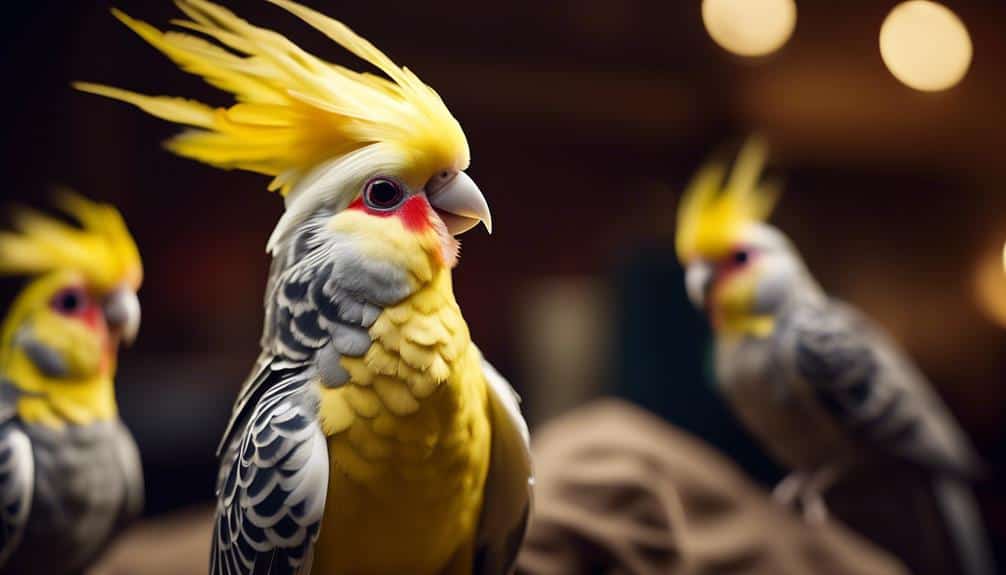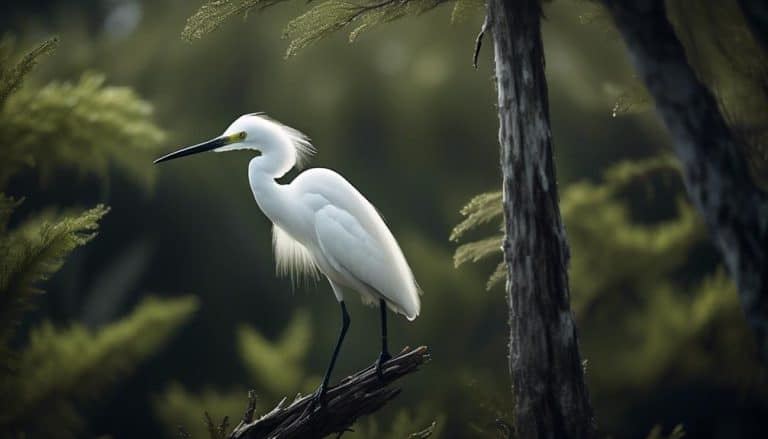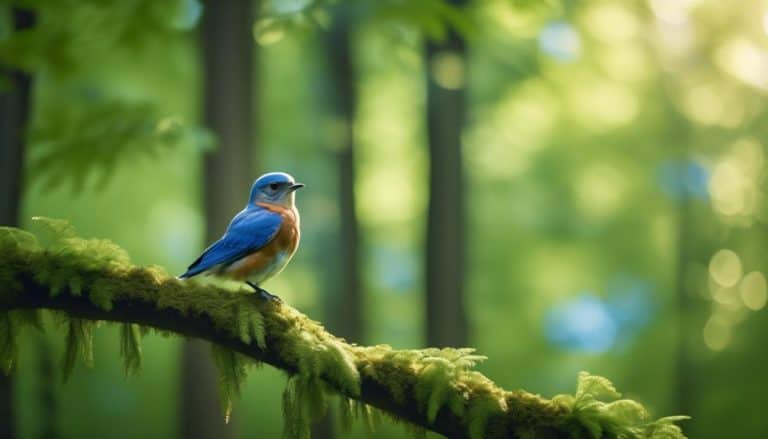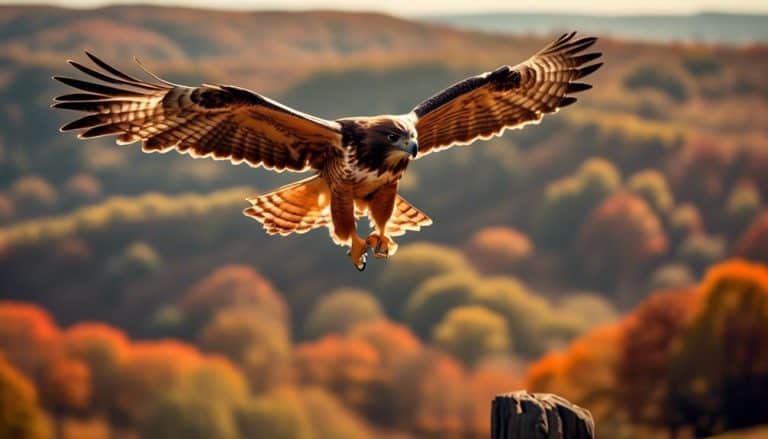As I sit here, captivated by the vibrant plumage of my feathered companion, I can't help but wonder about the fascinating world of cockatiel birds.
These charismatic creatures are not only known for their playful personalities, but also for their diverse range of colors and patterns.
From the striking contrast of the White-faced Cockatiels to the intricate markings of the Pearl Cockatiels, each type offers a unique and captivating beauty.
But that's not all – there are even more surprises awaiting, as we explore the enchanting world of Pied Cockatiels and Lutino Cockatiels.
So, if you're ready to embark on a journey into the captivating realm of these avian wonders, then join me as we uncover the secrets of these different types of cockatiels.
Common Cockatiel Varieties

There are several common varieties of cockatiel birds that exhibit distinct physical characteristics and colorations. One way to differentiate between male and female cockatiels is by observing their physical characteristics and behavior.
Male cockatiels generally have brighter and more vibrant colors compared to females. They often have a bright yellow face with bright orange cheek patches, while females have a more subdued gray face with pale orange cheek patches. In terms of behavior, male cockatiels are known for their singing and whistling abilities, which they use to attract females during courtship. Females, on the other hand, tend to be quieter and more reserved.
When it comes to ensuring the best diet for cockatiels, it's important to meet their nutritional needs. A well-balanced diet for cockatiels consists of a variety of fresh fruits, vegetables, seeds, and pellets. Leafy greens such as kale and spinach are excellent sources of vitamins and minerals for these birds. Additionally, offering a mix of different seeds like millet, sunflower, and safflower can provide essential fatty acids and proteins.
It's crucial to avoid feeding cockatiels foods that are toxic to them, such as avocado, chocolate, caffeine, and alcohol. Providing fresh water at all times is also essential for their overall health and wellbeing.
Pied Cockatiels: A Unique Coloration
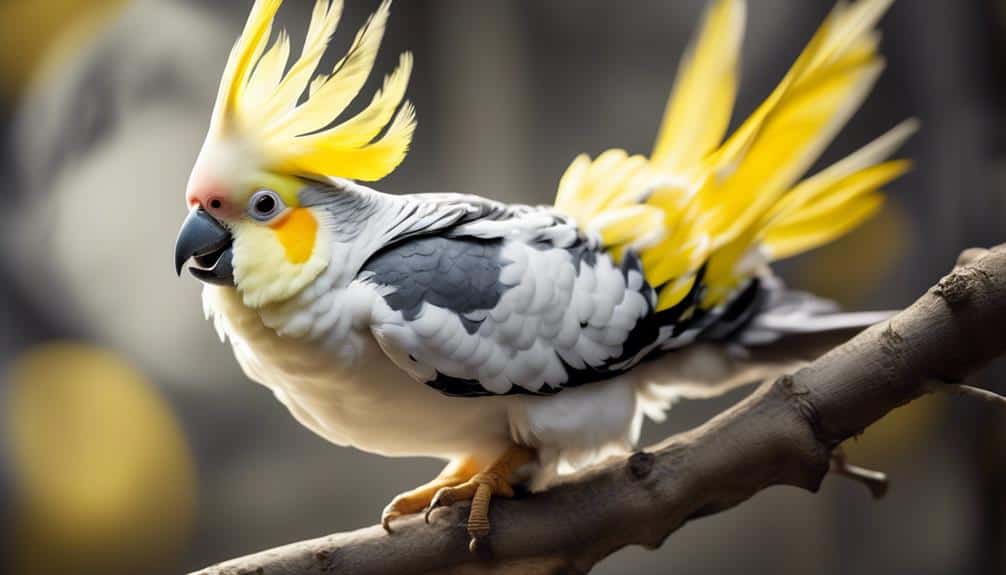
Pied Cockatiels display a distinctive coloration pattern characterized by patches of white or light-colored feathers interspersed with the typical grey or yellow plumage. This unique coloration sets them apart from other cockatiel varieties.
Here are some key features and characteristics of pied cockatiels:
- Patchy Appearance: The most notable feature of pied cockatiels is their patchy appearance. The patches of white or light-colored feathers can appear on various parts of their body, such as the wings, back, chest, and head.
- Varied Patterns: Pied cockatiels can exhibit different patterns of patches, ranging from small spots to large, irregular shapes. Each individual bird has a unique pattern, making them visually fascinating.
- Color Contrasts: The contrast between the white or light-colored patches and the typical grey or yellow plumage creates a striking visual effect. This color contrast enhances the beauty and appeal of pied cockatiels.
- Genetic Basis: The pied coloration is a result of a genetic mutation that affects the distribution of pigment in the feathers. This mutation can be inherited and passed down to future generations.
- Variations in Pied: There are different types of pied cockatiels, including dominant pied, recessive pied, and clear pied. Each type has distinct characteristics and inheritance patterns.
Lutino Cockatiels: The Bright Yellow Beauties
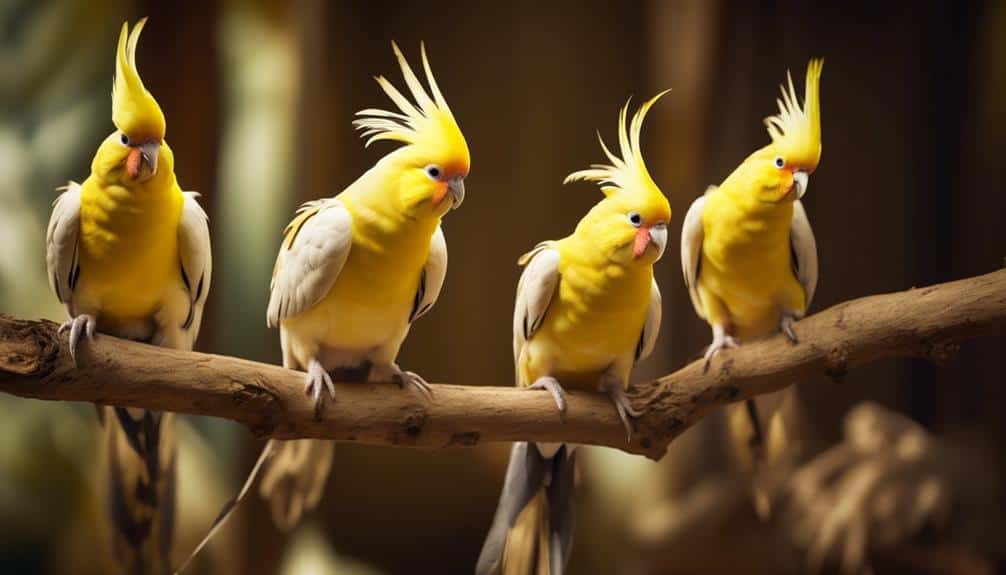
Lutino cockatiels, known for their vibrant yellow plumage, are a striking variation of the common cockatiel species. These bright yellow beauties are the result of a genetic mutation that affects the production of melanin, the pigment responsible for coloration in birds. Lutino cockatiels have a completely yellow plumage, including their crest, body, and tail feathers. Their eyes are red or pink, and their beaks and feet are a light pinkish color.
When it comes to breeding habits, lutino cockatiels can be bred with other mutations or with wild-type cockatiels to produce offspring with different color variations. However, it's important to note that breeding lutino cockatiels with other lutinos can lead to health issues, as the genetic mutation responsible for their coloration can also cause other genetic abnormalities. Therefore, it's recommended to breed lutino cockatiels with other mutations or with wild-type cockatiels to minimize the risk of health problems in the offspring.
In terms of diet and care, lutino cockatiels require a balanced and varied diet consisting of seeds, pellets, fresh fruits, and vegetables. They also need regular access to clean water and should be provided with a spacious cage that allows them to fly and exercise. Additionally, lutino cockatiels should be provided with toys and perches to keep them mentally stimulated and physically active. Regular veterinary check-ups are also important to ensure their overall health and well-being.
Pearl Cockatiels: Exquisite Markings and Patterns

Continuing our exploration of the diverse world of cockatiels, we now turn our attention to the captivating Pearl cockatiels, known for their exquisite markings and intricate patterns. These birds are truly a sight to behold, with their unique features that set them apart from other cockatiel varieties.
Some distinctive features of Pearl cockatiels include:
- Exquisite Patterns:
- The feathers of Pearl cockatiels display beautiful, intricate patterns that resemble tiny pearls scattered across their plumage.
- These patterns create a stunning visual effect and give the birds a distinct and elegant appearance.
- Distinctive Features:
- The most notable feature of Pearl cockatiels is their pearl-like markings, which cover their entire body.
- These markings are most prominent on their wings, tail, and back, creating a mesmerizing mosaic-like pattern.
- The coloration of the markings can vary, with some Pearls having a combination of white and gray, while others may have a more yellow or cinnamon hue.
White-faced Cockatiels: Striking Contrast and Elegance
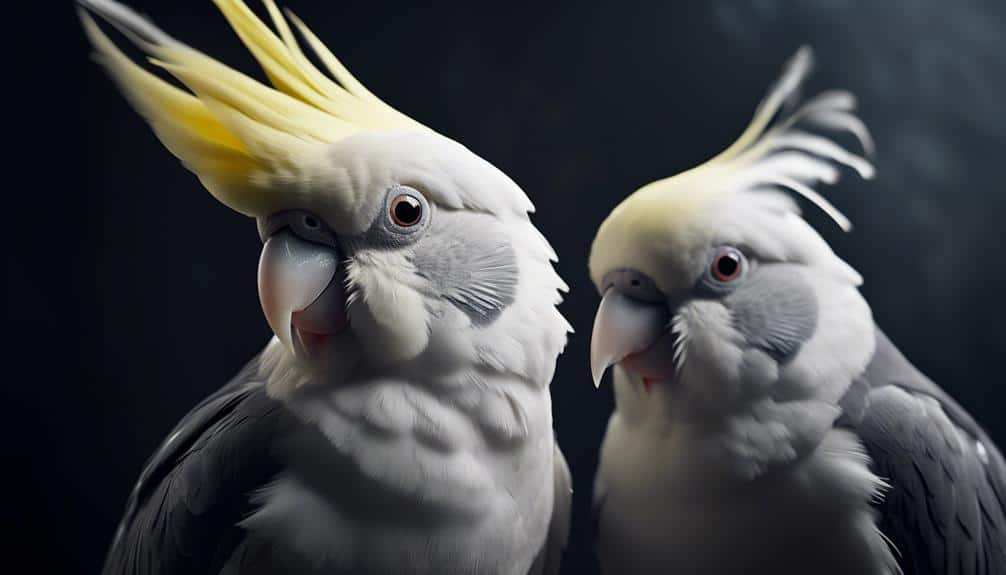
White-faced Cockatiels, with their striking contrast and elegant appearance, are a captivating variation of the cockatiel species. These birds have a unique genetic mutation that causes the absence of melanin, resulting in a pure white face with contrasting dark eyes. The white color extends from the face to their crest, giving them a stunning and eye-catching look.
In addition to their striking contrast, white-faced Cockatiels also possess an elegant demeanor. They have a graceful posture and move with a certain air of sophistication. Their feathers are typically a combination of soft gray and white, further enhancing their elegant appearance.
To better understand the characteristics of white-faced Cockatiels, let's take a closer look at their physical attributes in the table below:
| Physical Attributes | Description |
|---|---|
| Face Color | Pure white |
| Eye Color | Dark, contrasting |
| Crest Color | White |
| Body Feathers | Soft gray and white |
| Posture | Elegant and graceful |
White-faced Cockatiels are highly sought after by bird enthusiasts for their striking contrast and elegance. They make beautiful additions to any aviary or home, and their unique appearance is sure to capture the attention of anyone who sees them. Whether you are a seasoned bird owner or a newcomer to the world of cockatiels, these birds are sure to leave a lasting impression with their captivating beauty.
Frequently Asked Questions
Are There Any Health Concerns Specific to Cockatiels?
There are some health concerns specific to cockatiels. Common issues include respiratory infections, feather plucking, and fatty liver disease. Regular veterinary check-ups, a balanced diet, and providing a clean environment can help prevent these problems.
How Long Do Cockatiels Typically Live?
Cockatiels typically live for about 15 to 20 years, but their lifespan can be influenced by various factors such as diet, exercise, genetics, and overall care. Providing a balanced diet and a stimulating environment can help maximize their longevity.
Can Cockatiels Be Trained to Talk?
Yes, cockatiels can be trained to talk! It's truly amazing to hear these birds mimic human speech. Training methods, such as repetition and positive reinforcement, can help teach them common words like "hello" and "goodbye."
Do Cockatiels Require a Specific Diet?
Yes, cockatiels require a specific diet. They have unique feeding habits that consist of a mix of seeds, pellets, fresh fruits, and vegetables. However, it is important to consult with a veterinarian to determine if they need any additional supplements.
What Kind of Environment Is Best for Keeping Cockatiels as Pets?
I find that keeping pet cockatiels indoors is best for their well-being. It provides a controlled environment, protecting them from predators and extreme weather conditions. As for other pets, caution should be taken to ensure compatibility and safety.
Conclusion
As I observe the various types of cockatiels, each with their own unique colors and patterns, I can't help but be captivated by their beauty. These birds, with their vibrant hues and intricate markings, are a true symbol of nature's artistry.
It's a reminder of the incredible diversity and wonder that exists in the animal kingdom. With their striking contrast and elegance, cockatiels truly are a sight to behold.

